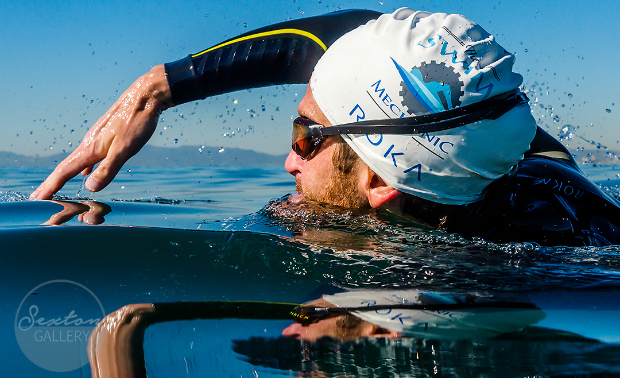
Blindly choosing which aspect of your swim stroke to address will lead you down a long and frustrating road of minimal progress. Swimming's highly technical nature demands a purposeful progression of mechanical focuses—regardless of your skill level.
Implementing a methodical approach will help create a solid swimming foundation. Only after you've successfully built this groundwork should you consider dedicating focus to power and swim speed. For now, finding efficiency in your stroke takes precedent. To do so, focus on the following three areas in this specific order.
Breathe Easy
The breath is king. Dialing in your breathing mechanics should always be the first focal point before any other aspect of your stroke is addressed.
Take time to regularly tune in to the rise and fall of your resting breath pattern. Before you push off the wall, try to mimic the same breathing pattern. It's important to balance the time spent inhaling oxygen with the period of time you expel CO2 waste.
Breathing to one side every stroke naturally creates a 1:1 ratio of inhaling for one second and seamlessly exhaling for one second. You'll be able to create and maintain some neutral buoyancy in the lungs and chest with this, ultimately optimizing your body posture in the water.
When you find yourself feeling especially fatigued, or with a high heart rate and a wandering mind, focus on resetting your breath. These are all common problems that can easily be remedied with an efficient breathing pattern.
Remember, breathe easy: Small sip of air in, followed by a relaxed exhale the second your face is in the water.
Where's Your Head?
How you align your body in the water affects how well you're able to move through it. Posture must be dialed in closely to keep your body from sinking and causing excess drag while swimming.
Imagine yourself as a giant shish kabob with your spine as the skewer. Like the pieces on the kabob, your head should be fixed in place, with no deviation during any phase of the stroke cycle. This positioning will allow for a consistent line in the water, creating a wave off of the head and subsequent trough next to your face to easily breathe into.
To achieve this posture, use the black line at the bottom of the pool as a visual reference point. With your line of sight three to four feet ahead of you on the black line, the water should break at the top third of your head, just a couple of inches behind your hairline.
This head position allows for maximal sight in front of you, proper spinal alignment and a clean pocket of air to breathe into.
Lift Your Legs
Modern technology and engineering has enabled wetsuit designers to create incredibly buoyant suits that nearly float you into perfect posture. While this is a massive advantage for open water swimming, it's easy to lose focus of the key functions and value of kicking.
Kicking produces only about 10 percent of total swim speed in open water. With such a low power output, why should you kick?
Tempo
To keep the specific movements in freestyle working together as one, it's imperative to sync your kick with your stroke. A six-beat kick (six kicks for each stroke cycle) tends to work most naturally for swimmers. Focus on kicking with a fluid, steady tempo without pausing during the breath.
Balance
Core engagement is the primary stabilizer that keeps you balanced, but the kick plays an equally important role of balancing you in the water while rotating. As one leg drives down, the opposite leg swings up, creating a counterbalance. Aim to keep your kicking range of motion between 12 to 15 inches from foot to foot. This tight profile helps reduce drag.
Lift
The down motion of your kick produces a lift force that allows both legs to stay lifted closer to the waterline. This is critical to maintaining long swimming posture.
Think of the driving down motion of the kick as the pulling motion of your stroke. The upswing of the leg, then, is synonymous with the arm recovery for each stroke. Without a steady downward kicking motion, your legs will struggle to stay lifted, which ultimately results in unnecessary drag.



